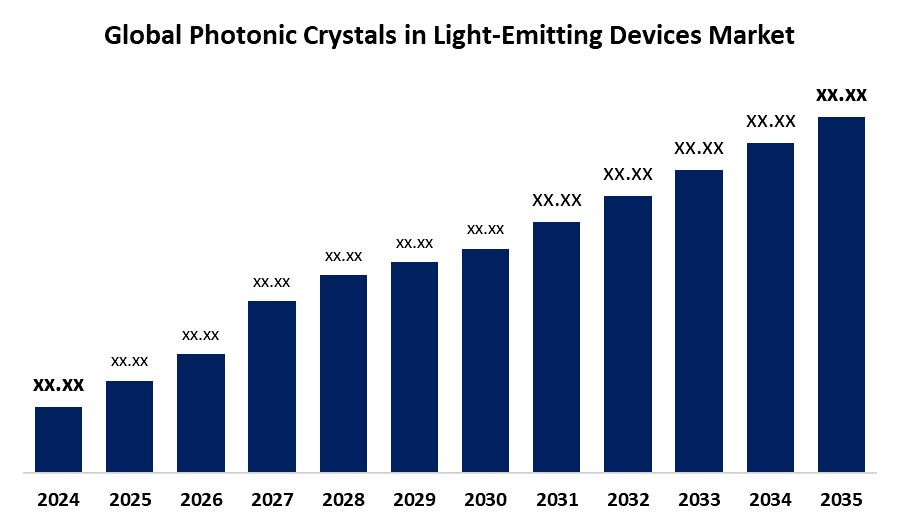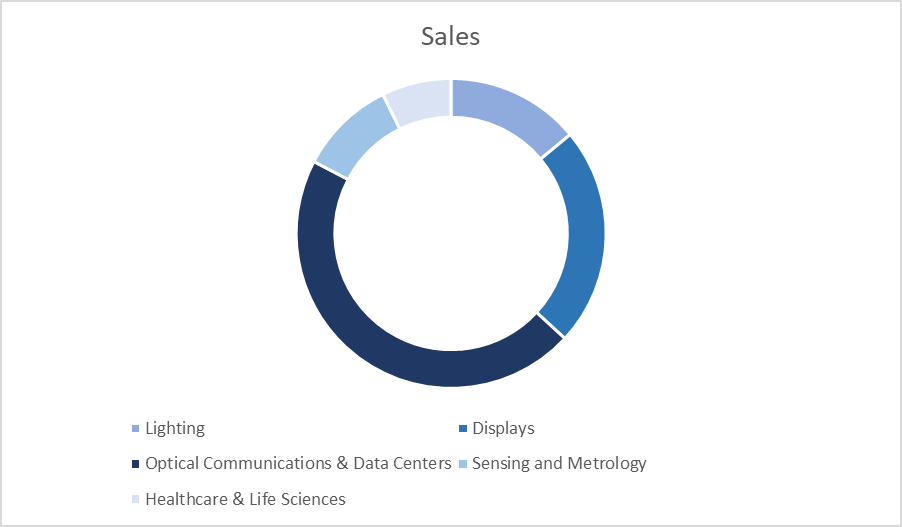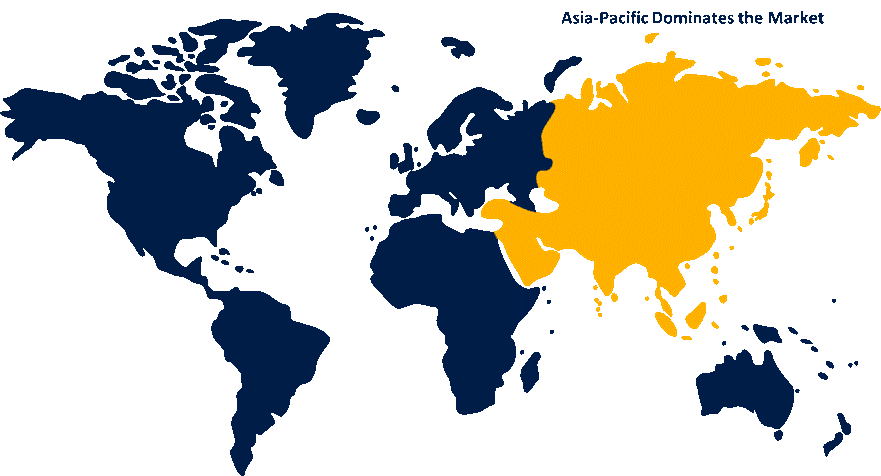Global Photonic Crystals in Light-Emitting Devices Market Size, Share, and COVID-19 Impact Analysis, Russia-Ukraine War Impact, Tariff Analysis, By Type of Photonic Crystal Structure (1D Photonic Crystals, 2D Photonic Crystal, 3D Photonic Crystals, and Photonic Quasi-Crystals), By Function (Light Extraction Efficiency Enhancement, Spectral Purity & Wavelength Control, Beam Shaping and Directionality Control and Polarization Control), By Application (Lighting, Displays, Optical Communications & Data Centers, Sensing and Metrology, and Healthcare & Life Sciences), and By Region (North America, Europe, Asia-Pacific, Latin America, Middle East, and Africa), Analysis and Forecast 2025 - 2035
Industry: Semiconductors & ElectronicsPhotonic Crystals in Light-Emitting Devices Market Summary, Size & Emerging Trends
According to Spherical Insights, the Global photonic crystals in light-emitting devices market Size is expected to hold a significant share by 2035, at a CAGR of 6.3% during the forecast period 2025-2035. Photonic crystals offer significant opportunities in light-emitting devices and lead to innovation in lighting, display, and optical communication technologies by increasing emission efficiency, allowing wavelength selection, reducing energy consumption, and enabling downsizing.

Get more details on this report -
Key Market Insights
- Asia Pacific is expected to account for the largest share in the photonic crystals in light-emitting devices market during the forecast period.
- In terms of technology, the 2D photonic crystal segment is projected to lead the photonic crystals in light-emitting devices market in terms of equipment throughout the forecast period
- In terms of function, the light extraction efficiency enhancement segment captured the largest portion of the market
- In terms of application, the optical communications & data centers segment captured the largest portion of the market
Global Market Forecast and Revenue Outlook
- CAGR (2025-2035): 6.3%
- Asia Pacific: Largest market in 2024
- North America: Fastest growing market
Photonic Crystals in Light-Emitting Devices Market
Photonic crystals are man-made materials with a periodic dielectric arrangement that influences the propagation of electromagnetic waves, especially light. In the marketplace of light-emitting devices, photonic crystals are used to manipulate and manage the emission properties of light sources like LEDs, OLEDs, and semiconductor lasers. Their novel ability to produce photonic band gaps allows for selective control of the light wavelengths, and increased light extraction, directionality, and customized emission spectra. By including photonic crystals in light-emitting devices, manufacturers can realize enhanced luminous efficiency, improved color purity, and less energy loss. The materials also allow for the creation of compact, low-threshold, and efficient optical components. The expansion in the photonic crystals in the light-emitting devices market is fueled by a number of influential factors based on technological innovation, energy efficiency needs, and changing application needs. High-efficiency lighting needs are one of the prime drivers. the surge in demand for sophisticated display technologies in consumer products, such as smartphones, TVs, and augmented reality (AR) devices, is driving photonic crystal adoption.
Photonic Crystals in Light-Emitting Devices Market Trends
- Increased integration of photonic crystals in LEDs and OLEDs to enhance light extraction and lower internal losses would improve the overall performance of the device.
- The creation of compact and highly integrated photonic crystal structures is a continuing trend that will help designers create lighter, more effective light-emitting components.
- Photonic bandgap engineering advancements have made it possible to precisely control emission wavelengths, supporting applications in optical communication, sensors, and displays. This allows for tunable and wavelength-selective emission.
- Growing need for better brightness, color accuracy, and sustainability has led to the adoption of photonic crystal technology in solid-state lighting, high-resolution displays, and energy-efficient illumination systems.
Photonic Crystals in Light-Emitting Devices Market Dynamics
Global Photonic Crystals in Light-Emitting Devices Market Report Coverage
| Report Coverage | Details |
|---|---|
| Base Year: | 2024 |
| Forecast Period: | 2025-2035 |
| Forecast Period CAGR 2025-2035 : | 6.3% |
| Historical Data for: | 2020-2023 |
| No. of Pages: | 210 |
| Tables, Charts & Figures: | 130 |
| Segments covered: | By Type of Photonic Crystal Structure, By Function and COVID-19 Impact Analysis |
| Companies covered:: | Nichia Corporation, Osram Opto Semiconductors, Lumentum Holdings Inc, Samsung Electronics, LG Innotek, SiO2 Materials LLC, Rohm Semiconductor, Sandia National Laboratories, and Others |
| Pitfalls & Challenges: | COVID-19 Impact, Challenges, Future, Growth, & Analysis |
Get more details on this report -
Driving Factors: Nanofabrication advances drive photonic crystal integration.
Developments in materials science and nanofabrication have made it easier to incorporate photonic crystal structures into light-emitting devices. Photonic crystals greatly improve luminous efficacy and promote international efforts toward energy conservation and sustainability by enabling improved light extraction and decreased energy losses in devices like LEDs and OLEDs. The photonic crystals in light-emitting devices market is expanding as a result of growing government initiatives and regulatory support for energy-efficient technologies. All of these elements work together to establish photonic crystals as a vital catalyst for innovation and performance improvement in the field of light-emitting devices.
Restrain Factors: High complexity and cost limit mass adoption.
Large-scale commercialization is hampered by high fabrication complexity and related manufacturing costs, especially in applications where cost is a concern. Further, precise nanofabrication methods which are time-consuming and technologically demanding are needed to integrate photonic crystal structures into current device topologies. Another barrier to broad adoption is the scarcity of standardized fabrication techniques and materials. In addition, market expansion may be hampered by a lack of technical know-how and industry knowledge about the application of photonic crystal technologies.
Opportunity: Photonic crystals meet demand for efficient optics.
The market for photonic crystals in light-emitting devices is booming due to the need for low-energy, high-efficiency optical solutions. They are perfect for next-generation LEDs, OLEDs, and laser diodes because of their capacity to improve light extraction, regulate emission directionality, and customize spectrum characteristics. Strong market potential is also created by growing applications in optical communications, biological imaging, and high-resolution displays. Adoption is further supported by the growing focus on energy-efficient lighting and sustainable technologies, which positions photonic crystals as a crucial enabler in the development of contemporary optoelectronic systems.
Challenges: High costs and complexity hinder commercial scalability.
Scalability and commercial acceptance are restricted by high production costs and complex fabrication procedures. Technical challenges arise from the need for sophisticated nanofabrication methods, and integration with current device platforms necessitates specific expertise. Device performance and dependability are further impacted by inconsistent material quality and a lack of established manufacturing procedures. Widespread implementation is further hindered by a lack of industry awareness and a sluggish market acceptance brought on by the technology's infancy.
Global Photonic Crystals in Light-Emitting Devices Market Ecosystem Analysis
The global ecosystem of the photonic crystals market for light-emitting devices includes important players such as suppliers of raw materials, manufacturers of components, manufacturers of devices, and end users from sectors like consumer electronics, automotive, and healthcare. Innovation and technical breakthroughs are fueled by cooperative relationships between academic institutions and business leaders. The availability of cutting-edge nanofabrication resources and facilities affects supply chain dynamics. The commercialization of photonic crystal technologies is facilitated by this integrated ecosystem, which also promotes growth in a variety of application industries globally and allows for improved device performance.
Global Photonic Crystals in Light-Emitting Devices Market, By Type of Photonic Crystal Structure
The 2D photonic crystal segment led the photonic crystals in light-emitting devices market, generating the largest revenue share. The excellent optical characteristics of 2D photonic crystals, such as effective control over light propagation and improved light extraction efficiency, are largely responsible for the segment growth of these devices. Their growing use in a variety of optoelectronic applications can be attributed to these characteristics taken together.
The 3D photonic crystals segment in the photonic crystals in light-emitting devices market is expected to grow at the fastest CAGR over the forecast period. Improvements in fabrication techniques and growing use in high-performance applications like lasers, solar cells, and quantum photonic systems are fueling the expansion of the three-dimensional (3D) photonic crystals market.
Global Photonic Crystals in Light-Emitting Devices Market, By Function
The light extraction efficiency enhancement segment held the largest market share in the photonic crystals in light-emitting devices market. The crucial function photonic crystals play in increasing light output by decreasing internal reflection and boosting directional emission of light is responsible for the light extraction enhancement segment. Their incorporation into OLEDs and LEDs has accelerated their widespread use, especially in lighting and display applications.
The beam shaping and directionality control segment in the v market is projected to register the fastest CAGR. The growing need for accurate light control in cutting-edge photonic applications, such as high-resolution screens, optical sensing, and next-generation communication systems, is propelling the beam shaping and directionality control market.
Global Photonic Crystals in Light-Emitting Devices Market, By Application
The optical communications & data centers segment held the largest market share in the photonic crystals in light-emitting devices market. The crucial role photonic crystals play in increasing data transmission efficiency, reducing signal loss, and expanding capacity in optical networks is the main factor driving the optical communications & data centers industry. The increasing need for cloud computing, data storage, and high-speed internet around the world has made photonic crystals essential to the functionality and scalability of contemporary communication systems.

Get more details on this report -
The displays segment in the photonic crystals in light-emitting devices market is projected to register the fastest CAGR. The growing need for high-brightness, energy-efficient displays and lighting solutions is driving the displays market. Photonic crystals improve light extraction and color quality, which boosts device performance and encourages broad use in consumer electronics and business applications.
Asia Pacific is expected to account for the largest share of the photonic crystals in light-emitting devices market during the forecast period.

Get more details on this report -
The Asia-Pacific region is credited with a strong manufacturing ecosystem in nations like China, Japan, and South Korea, as well as rapid industrialization and large investments in R&D. The region's focus on technical innovation and the growing need for cutting-edge optical technologies in industrial, healthcare, and telecommunications applications fuel market expansion. Additionally, the Asia-Pacific region is due to supportive government policies and efforts that encourage innovation.
The India is experiencing steady growth in the photonic crystals in light-emitting devices market. India is driven by the expansion of electronics manufacturing, supportive government policies such as the National Policy on Electronics, and increased investments in research and development in photonics and nanotechnology sectors.
North America is expected to grow at the fastest CAGR in the photonic crystals in light-emitting devices market during the forecast period. The main factors driving North America include the region's high focus on technological innovation, large R&D expenditures, and the existence of top semiconductor and optoelectronic producers. The development and commercialization of photonic crystal technology in a variety of applications are further facilitated by the region's established infrastructure and industry-academia collaboration.
The United States is the largest market for photonic crystals in light-emitting devices is driven by robust government support, sophisticated technology infrastructure, and considerable research and development efforts, all of which encourage innovation and adoption across a range of high-impact industries.
Competitive Analysis:
The report offers the appropriate analysis of the key organizations/companies involved within the photonic crystals in light-emitting devices market, along with a comparative evaluation primarily based on their type of offering, business overviews, geographic presence, enterprise strategies, segment market share, and SWOT analysis. The report also provides an elaborate analysis focusing on the current news and developments of the companies, which includes product development, innovations, joint ventures, partnerships, mergers & acquisitions, strategic alliances, and others. This allows for the evaluation of the overall competition within the market.
WORLDWIDE TOP KEY PLAYERS IN THE PHOTONIC CRYSTALS IN LIGHT-EMITTING DEVICES MARKET INCLUDE
- Nichia Corporation
- Osram Opto Semiconductors
- Lumentum Holdings Inc
- Samsung Electronics
- LG Innotek
- SiO2 Materials LLC
- Rohm Semiconductor
- Sandia National Laboratories
- Others
Key Target Audience
- Market Players
- Investors
- End-users
- Government Authorities
- Consulting And Research Firm
- Venture capitalists
- Value-Added Resellers (VARs)
Product Launches in Photonic Crystals in Light-Emitting Devices
- In November 2024, Q.ANT announced its first commercial product, a Native Processing Unit (NPU) based on photonics and built on its patented LENA architecture. It is PCI-Express compatible and can be easily integrated into current computer ecosystems.
Market Segment
This study forecasts revenue at global, regional, and country levels from 2020 to 2035. Spherical Insights has segmented the photonic crystals in light-emitting devices market based on the below-mentioned segments:
Global Photonic Crystals in Light-Emitting Devices Market, By Type of Photonic Crystal Structure
- 1D Photonic Crystals
- 2D Photonic Crystal
- 3D Photonic Crystals
- Photonic Quasi-Crystals
Global Photonic Crystals in Light-Emitting Devices Market, By Function
- Light Extraction Efficiency Enhancement
- Spectral Purity & Wavelength Control
- Beam Shaping and Directionality Control
- Polarization Control
Global Photonic Crystals in Light-Emitting Devices Market, By Application
- Lighting
- Displays
- Optical Communications & Data Centers
- Sensing and Metrology
- Healthcare & Life Sciences
Global Photonic Crystals in Light-Emitting Devices Market, By Regional Analysis
- North America
- US
- Canada
- Mexico
- Europe
- Germany
- UK
- France
- Italy
- Spain
- Russia
- Rest of Europe
- Asia Pacific
- China
- Japan
- India
- South Korea
- Australia
- Rest of Asia Pacific
- South America
- Brazil
- Argentina
- Rest of South America
- Middle East & Africa
- UAE
- Saudi Arabia
- Qatar
- South Africa
- Rest of the Middle East & Africa
Frequently Asked Questions (FAQ)
-
1. What is the CAGR of the photonic crystals in light-emitting devices market over the forecast period?The global photonic crystals in light-emitting devices market is projected to expand at a CAGR of 6.3% during the forecast period.
-
2. What is the market size of the photonic crystals in light-emitting devices market?The global photonic crystals in light-emitting devices market Size is expected to hold a significant share by 2035, at a CAGR of 6.3% during the forecast period 2025-2035.
-
3. Which region holds the largest share of the photonic crystals in light-emitting devices market?Asia Pacific is anticipated to hold the largest share of the photonic crystals in light-emitting devices market over the predicted timeframe.
-
4. Who are the top 10 companies operating in the global photonic crystals in light-emitting devices market?Key players include in Nichia Corporation, Osram Opto Semiconductors, Lumentum Holdings Inc., Samsung Electronics, LG Innotek, SiO2 Materials LLC, Rohm Semiconductor, Sandia National Laboratories, and Others.
-
5. What factors are driving the growth of the photonic crystals in light-emitting devices market?The photonic crystals in light-emitting devices market growth is driven by increasing demand for energy-efficient lighting, advancements in display technologies, rising adoption in optical communications, and expanding applications in healthcare and sensing.
-
6. What are the main challenges restricting wider adoption of the photonic crystals in light-emitting devices market?The primary challenges restricting wider adoption include high production costs, complex manufacturing processes, limited scalability, and insufficient standardization, which collectively hinder large-scale commercialization and widespread integration of photonic crystal technologies.
Need help to buy this report?